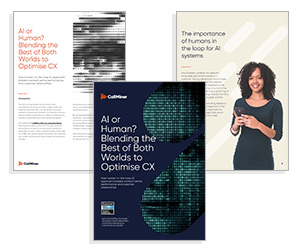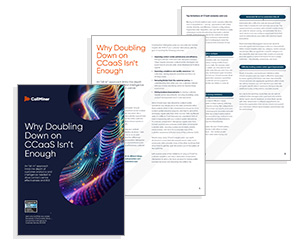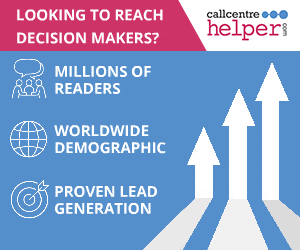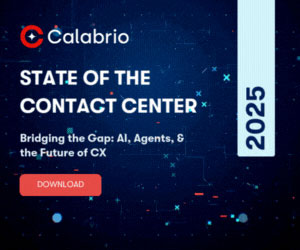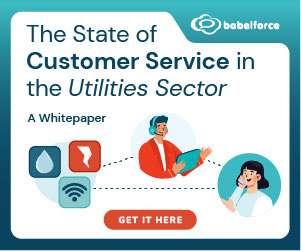CallMiner explores how ecommerce brands can create standout customer experiences that drive loyalty, improve satisfaction, and build lasting customer relationships in a competitive digital marketplace.
Ecommerce brands are a dime a dozen in today’s competitive retail landscape, but an exceptional customer experience (CX) strategy can be the differentiator between a memorable brand and one that gets lost in the shuffle.
Customers not only expect quality products, but also genuine and personalized support that makes them feel truly respected and appreciated by the ecommerce brands they choose to give their money to.
What is Ecommerce Customer Experience (CX)?
Ecommerce CX refers to the collective interactions a customer has with an ecommerce brand and how they perceive the brand as a result. This includes their experiences before they visit a retailer’s website, during their visit, and post-purchase.
Delivering an exceptional ecommerce customer experience fosters trust and customer loyalty, driving repeat business, word-of-mouth marketing, and revenue.
Competition is fierce in the ecommerce industry today, and many retailers compete primarily on CX, making it a key priority for all ecommerce businesses.
6 Key Factors of Exceptional Ecommerce Customer Experience
Personalized Experiences
Personalized experiences cater to individual customer preferences and needs, creating more relevant and engaging shopping experiences for every customer who visits your site.
Tailored product recommendations, targeted ads and promotions, and custom support can enhance the overall user experience and help customers feel highly valued and understood.
When a customer feels like the brand they’re doing business with understands their needs, they could be more likely to become a repeat buyer. In fact, 62% of customers said a brand would lose their loyalty if they failed to deliver personalized experiences.
Customer Feedback Analysis
A business can gather valuable insights about what customers want, need, and expect through customer feedback analysis.
Customer feedback can come from multiple channels, like social media, reviews, and post-purchase surveys, each allowing businesses to identify pain points, areas for improvement, and places where they excel.
Businesses then use this information to make informed decisions to enhance CX by addressing concerns and doing more of what customers appreciate.
Plus, customers believe their feedback is crucial and want to share it. SurveyMonkey research found that 91% of customers believe businesses should make innovative choices based on customer feedback rather than teams of experts.
Loyalty Programs
Loyalty programs incentivize repeat purchases and encourage customers to form deeper relationships with the brands they love.
Ecommerce businesses can offer rewards, discounts, and exclusive perks to customers who continue to come back to the business and purchase products or services.
For example, Sephora’s Beauty Insider program offers free shipping, free birthday gifts, and special events during the year with exclusive discounts and extra point offerings for members.
As members spend more through the year, they move up the ranks for additional perks, like higher discounts and early access to new products, incentivizing them to keep coming back and spending more at Sephora.
Memorable Customer Service Experiences
Customers are more likely to stick with a company that provides exceptional customer service experiences that they can rely on.
Salesforce research found that 78% of customers would forgive a company’s mistake if the company provided excellent customer service to resolve the issue, indicating a likelihood for the customer to return.
Prompt, helpful, and personalized support blended with genuine empathy can foster deep emotional connections with a brand.
Consistency and Reliability
Customers want to know that they can rely on an ecommerce brand to continue giving them what they need.
That consistency and reliability will make customers feel secure in their purchasing decisions, whether they realize they can count on a brand for fast shipping, quick issue resolution, or reliable website or app performance.
Omnichannel Support
Today’s ecommerce businesses have customers with multiple needs and preferences, including the ways they want to reach out to a company.
Therefore, ecommerce companies should provide a seamless experience across multiple channels, like phone, social media, email, and live chat, to cater to these varied preferences.
Omnichannel support lets customers get the help they need when they need it through increased responsiveness and convenient resolutions.
Elevate Your Brand Loyalty With Customer Experience Software
Brand loyalty relies on exceptional ecommerce customer experiences. Consistent and helpful support, personalized interactions, and seamless omnichannel support are a few high-priority ways ecommerce businesses can encourage more loyal customers.
Customer experience software can make it easier to streamline this process by tracking feedback, making workflows more efficient, gathering data, and mapping the customer journey.
Frequently Asked Questions
How Does Customer Experience Impact Ecommerce Success?
A positive customer experience builds customer satisfaction, in turn fostering loyalty and encouraging repeat purchases.
Positive interactions with a company can boost conversion rates and customer lifetime value, two crucial metrics in determining the success of an ecommerce business.
What Are Some Cost-Effective Ways to Improve Ecommerce Customer Experience?
Efficiency is important when it comes to reducing the costs associated with ecommerce customer experience.
Finding ways to streamline data collection and insights, like providing omnichannel support and asking customers for feedback across multiple touchpoints, can improve efficiency.
You can also offer self-service options and optimize your website and checkout process for mobile shoppers, making the overall shopping experience more enjoyable for the masses.
How Can I Measure The Success of My Ecommerce Customer Experience Efforts?
Track metrics that focus on customer experience to determine whether your efforts are successful. Important CX metrics include Net Promoter Score (NPS), customer satisfaction (CSAT), customer retention rate, and customer lifetime value (CLTV).
This blog post has been re-published by kind permission of CallMiner – View the Original Article
For more information about CallMiner - visit the CallMiner Website
Call Centre Helper is not responsible for the content of these guest blog posts. The opinions expressed in this article are those of the author, and do not necessarily reflect those of Call Centre Helper.
Author: CallMiner
Reviewed by: Rachael Trickey
Published On: 20th May 2025
Read more about - Guest Blogs, CallMiner






 CallMiner is the leading cloud-based customer interaction analytics solution for extracting business intelligence and improving agent performance across all contact channels.
CallMiner is the leading cloud-based customer interaction analytics solution for extracting business intelligence and improving agent performance across all contact channels. 




